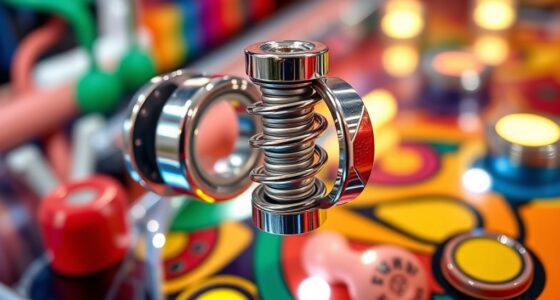To boost your high scores, master both nudging and ball control by staying calm and focused. Use precise nudging to position the ball advantageously without risking mistakes, and practice timing your touches for smooth control. Stay aware of the game rhythm and anticipate moves, which helps you make smarter decisions. Developing mental resilience and fine-tuning your techniques will maximize your effectiveness—keep going, and you’ll uncover even more tips to elevate your game further.
Key Takeaways
- Develop precise timing to execute nudges and ball control actions at optimal moments.
- Use mental clarity to anticipate ball movements and position your paddle proactively.
- Synchronize your movements with game rhythm for smoother ball control and effective nudging.
- Maintain composure under pressure to make accurate adjustments without rushing.
- Practice reading upcoming shots to combine mental resilience with technical execution for high scores.

Ever wondered what it takes to achieve high scores consistently? It’s not just about quick reflexes or luck; it’s about understanding the nuances of player psychology and mastering timing techniques. When you focus on these aspects, you can stay calm under pressure, make smarter decisions, and execute moves with precision. Player psychology plays a pivotal role because your mindset influences how you approach each game. If you’re confident and composed, you’re less likely to make impulsive mistakes. Recognizing your tendencies—whether you tend to rush or hesitate—allows you to adjust your strategy. For example, if you notice yourself panicking when the pace quickens, take a deep breath and slow down. This mental clarity helps you maintain control, which is essential for building high scores. Developing mental resilience is key to staying focused during challenging moments, enabling sustained high performance. Timing techniques are equally essential. Success in games often hinges on your ability to execute actions at just the right moment. Whether it’s hitting a button, tapping the screen, or maneuvering a joystick, perfect timing can make the difference between a mediocre score and a record-breaking one. To develop these skills, practice observing patterns and anticipating moves. By predicting what’s coming next, you can prepare your inputs in advance and execute them seamlessly. This “reading ahead” approach minimizes hesitation, allowing you to respond swiftly and accurately. Over time, your muscle memory becomes finely tuned, making your actions feel natural and instinctive. You should also pay attention to the rhythm of the game. Many successful players synchronize their movements with the game’s tempo, which enhances timing accuracy. This means listening to audio cues, watching visual signals, or simply feeling the flow of the gameplay. When you’re in sync with the game’s rhythm, your reactions become more precise, and you can capitalize on opportunities for high scoring combos or streaks. Combining this with a solid understanding of player psychology—like knowing when to take risks and when to play conservatively—boosts your overall performance. Ultimately, achieving high scores isn’t just about quick reactions; it’s about cultivating a mindset that stays focused and composed, paired with sharp timing skills. By improving your mental approach and honing your timing techniques, you’ll find yourself making smarter moves, avoiding unnecessary errors, and steadily climbing higher on the leaderboard. Success in these games is a blend of mental resilience and technical mastery—once you get both right, high scores will become a natural outcome.
Frequently Asked Questions
How Can I Improve My Reaction Time for Better Ball Control?
To improve your reaction time for better ball control, focus on reaction training and cognitive exercises. Practice quick decision-making drills and reaction-based games to sharpen your reflexes. Incorporate activities like juggling or reaction lights to enhance your responsiveness. Consistently challenging your brain and body helps you react faster during gameplay, giving you better control over the ball and increasing your overall performance on the field.
What Are Common Mistakes to Avoid When Nudging Opponents?
Imagine walking a tightrope—you want balance, not sudden jerks. When nudging opponents, avoid sportsmanship pitfalls like overly aggressive tactics or abrupt moves that can cause disputes. Always aim for subtle, controlled touches; otherwise, you risk penalties or losing respect. Remember, smooth, respectful nudging keeps the game fair and enjoyable. Overly aggressive tactics might win a point temporarily, but they can damage your reputation long-term. Stay confident, stay respectful.
Which Training Drills Best Enhance Strategic Ball Placement?
You should focus on drill variations that emphasize placement accuracy, like target zones or cone placements, to improve strategic ball placement. Practice consistently hitting specific spots on the court, adjusting your angle and power to refine precision. Incorporate diverse drills that challenge you to adapt under pressure, helping you develop better control and decision-making for strategic placement during matches. This approach sharpens your skills and boosts overall performance.
How Does Player Positioning Influence Scoring Opportunities?
Your positioning directly influences scoring chances by optimizing player spacing and boosting positional awareness. When you stay aware of your teammates’ locations, you can create better passing lanes and exploit gaps in the opposition’s defense. Proper spacing allows you to move efficiently and stay unpredictable, increasing your chances of receiving the ball in a prime scoring position. Focus on maintaining good positional awareness, and you’ll find scoring opportunities become more frequent and easier to capitalize on.
Are There Specific Mental Techniques to Maintain Focus During High-Pressure Games?
Think of your mind as a tightrope walker; staying balanced under pressure requires focus. You can achieve this with mindfulness training, which sharpens your attention, and mental visualization, helping you rehearse success. When tension rises, take deep breaths, visualize positive outcomes, and anchor your thoughts. These techniques keep distractions at bay, so you stay locked in and perform at your best, even when the stakes are high.
Conclusion
By mastering these strategies, you’re like a skilled captain steering your ship through turbulent waters, always mindful of the winds and currents. Just as a painter carefully brushes each stroke to create a masterpiece, your control and nudging refine your game, elevating your scores. Remember, greatness isn’t achieved overnight—it’s built through patience and precision. Keep honing your skills, and soon you’ll find yourself reaching new heights, as if guided by the steady hand of a seasoned navigator charting a course to victory.









